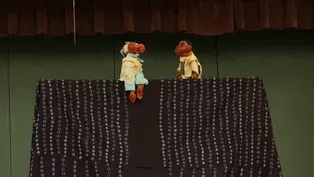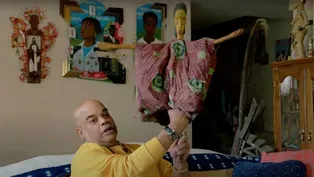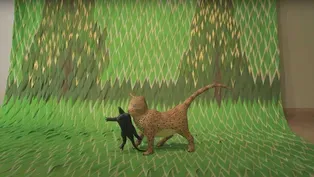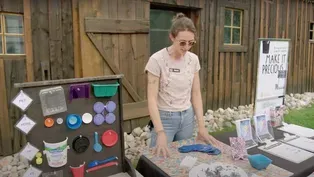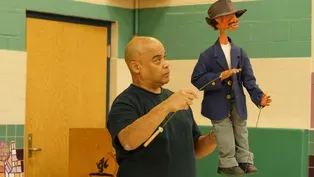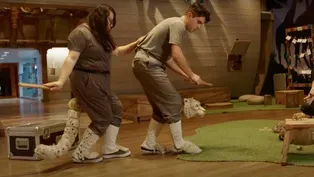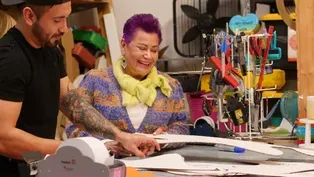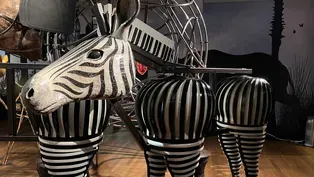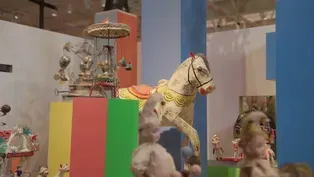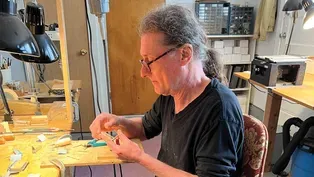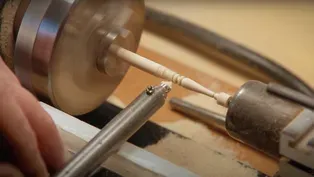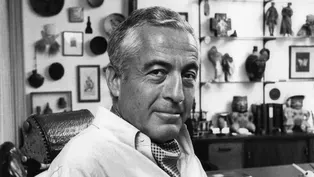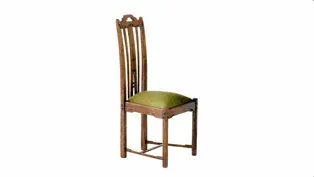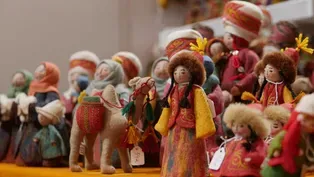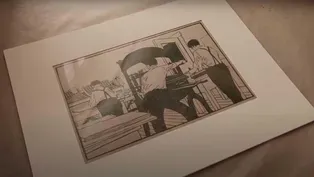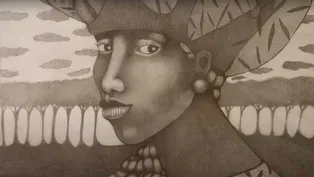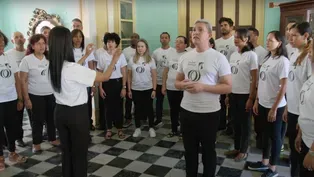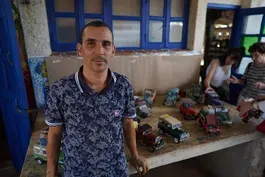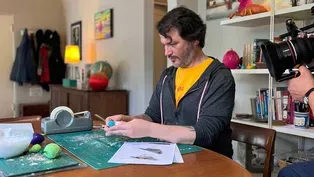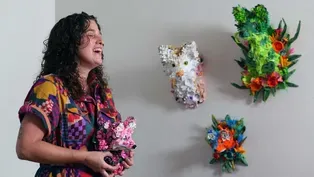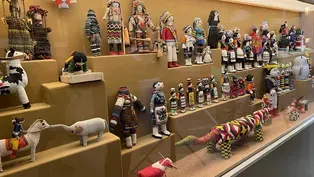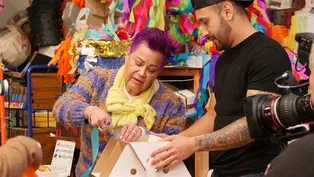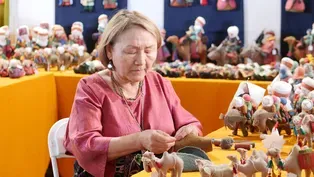
Puppeteer Schroeder Cherry segment
Clip: Season 15 | 10m 29sVideo has Closed Captions
How puppets can become vehicles of history & change: the work of Schroeder Cherry
In Baltimore, artist and museum educator Schroeder Cherry introduces us to his cast of handmade puppets. Dr. Cherry puts on puppet shows to share African American history with children and adults alongside his practice as a painter and assemblage artist. Segment from PLAY episode
Problems with Closed Captions? Closed Captioning Feedback
Problems with Closed Captions? Closed Captioning Feedback

Puppeteer Schroeder Cherry segment
Clip: Season 15 | 10m 29sVideo has Closed Captions
In Baltimore, artist and museum educator Schroeder Cherry introduces us to his cast of handmade puppets. Dr. Cherry puts on puppet shows to share African American history with children and adults alongside his practice as a painter and assemblage artist. Segment from PLAY episode
Problems with Closed Captions? Closed Captioning Feedback
How to Watch Craft in America
Craft in America is available to stream on pbs.org and the free PBS App, available on iPhone, Apple TV, Android TV, Android smartphones, Amazon Fire TV, Amazon Fire Tablet, Roku, Samsung Smart TV, and Vizio.
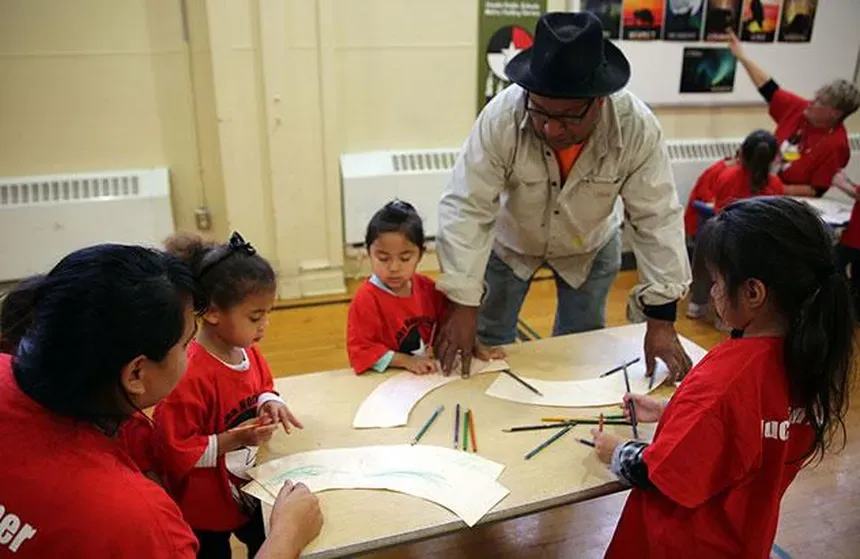
Education Guides
Download Craft in America education guides that educate, involve, and inform students about how craft plays a role in their lives, with connections to American history and culture, philosophies and science, social causes and social action.Providing Support for PBS.org
Learn Moreabout PBS online sponsorship♪♪ Schroeder: My career is a triumvirate.
I've been an artist, a puppeteer, and a museum educator, and those things have been the three focuses of what I've been involved with throughout my life.
♪♪ My mom gave me puppets when I was a kid.
I played with marionettes.
I still have a marionette from third grade, so I played with string puppets from early on, and then I moved to hand puppets.
I stopped playing with puppets in high school, and then in college, I realized I really enjoyed playing with puppets.
"All right, all right, all right.
"I'm Smooth Earl, and I'm one of the puppets "in "Schroeder Cherry and his Puppets."
"We're a family, you know?
We're like a family.
Yeah.
"We got a lot.
"We got Ms. Lily, Dallas Dan, Africa Brown.
"You want me to keep going?
Because there's a bunch of us.
There's a whole bunch."
♪♪ This type of puppet is called a rod puppet, and the body itself is made pretty much like a doll, but the hands and the head are sculpted out of a wood.
The rod, I hold it from the bottom, but it goes through the body, through the chest, up into the neck, and it supports the head.
On the inside, there's a spring in the mouth, so when I pull a string which comes down here, I have one finger on the mouth, and my thumb is controlling the eyes, so when I move my thumb like this, the eyes open and close, and for the hands, one rod to each hand, so when I'm performing, I'm performing with one hand or two hands and then that kind of movement, so the hands are operated with the rods.
"I am Maya Opinion, and my thought for today is, it's a lovely day."
[Slurps] "Ahh, that's my opinion for the day."
♪♪ Growing up in Washington, D.C., I did have a pretty big playground.
I used to wander through the Smithsonian Institution.
You don't have to pay to go into a Smithsonian, so I could just go in through the doors... ♪♪ and it has had an impact on my life.
♪♪ Now I'm the curator for the James E. Lewis Museum of Art, also known as JELMA.
♪♪ So in this gallery, you've got works by Ernest Shaw, well-known Baltimore artist who's known for portraiture.
JELMA is on Morgan State University's campus, and we have a collection of African, Asian, European, and American art.
You can see his face, but if you look at the line drawing, that's an older version of this kid, so that's something that he's using in his work.
I was trained as a painter on canvas.
Later, I got my doctoral degree and focused on museum education.
♪♪ Museums do a really good job in helping people to understand the world, whether it's science or history.
Art museums let us know what artists are dealing with in the past or present and what they imagine might happen in the future, so it's all about imagination.
♪♪ "I'm Ms. Lily, and I am the puppet docent of the troupe, "so I give tours to adults, mainly in museums and galleries.
"Most recently, we were at the National Museum "of African American History and Culture, "and I had the opportunity to identify six objects "that the museum had recently acquired, "including a shawl of Harriet Tubman "that was given to her by Queen Victoria "and Nat Turner's Bible.
That was quite exciting."
Lily was delivering this tour, and I noticed that a couple of people were kind of unnerved when they realized that the voice they were listening to was a puppet.
I heard a couple of gasps like, "Oh, my God!"
Ha ha ha!
[Drill whirring] I'm a painter, but over time, I've become an assemblagist.
I do a sketch, and then I start adding objects to the piece.
[Router whirring] I'm using wood like a canvas.
I sew into wood.
I'm attaching things.
♪♪ Because my works tend to be narrative, whenever I add an object, the object lends to that storyline.
♪♪ The cards have become a part of the material that I use in the work with the assemblages, and they become to mean, "What do you do in life with the cards that you're dealt?"
♪♪ "When you talk about Dr. Cherry's assemblage, "I would talk about the different series "that he's worked on.
"I think he has 68 paintings in the "BarberShop" series.
"He tends to work in these series "because that gives him an idea of a narrative, and he just explores that as far as it will go."
♪♪ "The current series, The 'Future Voters,' he's up to number 22, I believe."
♪♪ [Drill whirring] During COVID, I birthed, like, five different puppets.
I sculpt the heads and the hands out of a plastic wood, and I sew the bodies.
The eyes are made out of ping pong balls.
They have a rod that goes in through the head to the other side.
Their face really comes to life when the mouth mechanism is connected and when you can see the eyes open and close.
Even the way the mouth moves can impact the voice that they're gonna have a little later.
"Oh, yeah.
My name is Tevin-- that's spelled with a T-- "and when we do shows, he's good at packing us and taking us around..." "because when we have to go places, "we have to be put in a trunk or a bag, and it gets really dark inside that trunk."
"He works us, though, because, you know, "every time we do a show, we got to do rehearsal.
"We got to do it again and again and again.
He's like that."
♪♪ Underground Railroad, ♪ not a subway ♪♪ ♪♪ He couldn't read, ♪ he died on his feet... ♪♪ The show that I have called "Underground Railroad, Not a Subway" is narrated by an older gentleman--Mr. Zeke.
First, when he shows up, the kids are laughing at him because many of them have never seen a Black puppet... Zeke: Have you ever lost something, something you wanted back real bad?"
Schroeder: but when Mr. Zeke starts speaking, that's when I hear the hush.
Boy: What's an underground railroad?
Woman: It's not a thing you can see, exactly.
It's something that helps slaves get to freedom.
Boy: Oh.
Schroeder: The show itself is about a little boy who runs away from slavery.
Boy: I don't want to be a slave all my life, so here I go.
Schroeder: We're getting across the fact that enslaved Black people did want to escape, and there were things that they had to do that were very dangerous.
Man: Did you see it?
Can you tell me where it is?
I want it back, and I want it back now.
Schroeder: Slave owners thought they lost something because they considered those people their property.
Man: I gives it a good home, and I takes care of it, so it's mine, right?
Children: No!
[Shouting] Schroeder: It's pretty dense with information, but, because it's a puppet show and it's done in fun ways, the audiences absorb a lot, I think.
♪♪ Underground Railroad ♪ had conductors ♪♪ ♪♪ Helped the slaves ♪ get away to freedom ♪♪ ♪♪ Black, brown, red, and white ♪♪ ♪♪ They helped the slaves ♪ stay out of sight ♪♪ With play, you are relaxed enough to be able to receive information.
Even if it's subconsciously, you'll be able to absorb information much more easily.
Girl: I liked the show because it was, like, important because they were showing you what happened a long time ago.
Boy: I learned that the Underground Railroad was a secret.
♪♪ [Applause] Schroeder: And that's our story for today.
Child: Bravo!
Bravo!
Schroeder: "Adults don't play enough, don't you think?
"They just have to bring in that inner child.
"I think we all have the inner child, "but we lose it when we become adults, "and it just goes somewhere.
"That's so unfortunate.
That's just my opinion, yeah?"
[Slurps] "Ahh.
Yes.
Play is very important."
♪♪
Woodblock print & marionette maker Gustave Baumann segment
Video has Closed Captions
Multidisciplinary artist, Gustave Baumann, was deeply inspired by Santa Fe (12m 16s)
Underground Railroad, Not a Subway by Schroeder Cherry
Video has Closed Captions
Schroeder Cherry's puppetry performance, Underground Railroad, Not a Subway (25m 34s)
Schroeder Cherry's Civil Rights Childrens Crusade
Video has Closed Captions
Schroeder Cherry's puppetry performance, Civil Rights Childrens Crusade (9m 53s)
Schroeder Cherry's African Puppets
Video has Closed Captions
Artist, puppeteer, museum educator Schroeder Cherry on African puppets in his collection (2m 36s)
Roberto Benavidez on creating piñatas & "piñathkos"
Video has Closed Captions
Artist Roberto Benavidez speaks with curator and art historian on his piñatas & piñathkos (1m 49s)
Recycling plastic through Precious Plastic program
Video has Closed Captions
Sustainability coordinator on recycling plastic through their Precious Plastic program (54s)
Puppeteer Schroeder Cherry segment
Video has Closed Captions
How puppets can become vehicles of history & change: the work of Schroeder Cherry (10m 29s)
Puppeteering the snow leopard at Noah's Ark
Video has Closed Captions
Kinetic designer Chris Green works with Noah's Ark educators on puppeteering snow leopard (1m 47s)
Piñata maker Lorena Robletto segment
Video has Closed Captions
Lorena Robletto creates festive and creative piñatas with fair labor practices at her business, Amaz (6m 14s)
Noah's Ark at the Skirball segment
Video has Closed Captions
Noah's Ark animals made using repurposed materials & Skirball's puppet fest (12m 10s)
Multiple Visions: A Common Bond
Video has Closed Captions
Alexander Girard's folk art collection at Museum of International Folk Art Museum (1m 20s)
Miniaturist Mark Murphy segment
Video has Closed Captions
Woodworker makes tiny furniture: Meet miniaturist Mark Murphy (10m 31s)
Mark Murphy shows us his miniature furniture
Video has Closed Captions
Miniaturist Mark Murphy shows us his miniature 1/12th scale furniture (2m 19s)
Lloyd Cotsen & the Cotsen Children's Library segment
Video has Closed Captions
Lloyd Cotsen founded the Cotsen Children’s Library at Princeton University (5m 45s)
Video has Closed Captions
Lloyd Cotsen's collection of Chinese bronze mirrors, textiles, folk art, Japanese baskets (5m 22s)
International Guild of Miniature Artisans
Video has Closed Captions
Barbara Davis on the International Guild of Miniature Artisans and their Guild School (2m 27s)
International Folk Art Market segment
Video has Closed Captions
Meet artisans at the International Folk Art Market (9m 5s)
International Folk Art Market basket weaver
Video has Closed Captions
Master basket weaver Nelsiwe Dlamini at International Folk Art Market (1m 57s)
Gustave Baumann's Printing the Democrat woodblock print
Video has Closed Captions
Thomas Leech on Gustave Baumann's woodblock print, The Print Shop/Printing the Democrat (1m 10s)
Video has Closed Captions
JELMA curator Schroeder Cherry invites artist Espi Frazier to show her work in the gallery (1m 16s)
El Orfeon Santiago Chorus performance - bonus video from MINIATURES (1m 23s)
Cuban artist Leandro Gómez Quintero segment
Video has Closed Captions
Small scale model cars by Cuban artist Leandro Gómez Quintero (13m 43s)
Calder Kamin on Austin Creative Reuse
Video has Closed Captions
Artist Calder Kamin on how she discovered Austin Creative Reuse (1m 18s)
Artist Roberto Benavidez segment
Video has Closed Captions
Roberto Benavidez's piñatas inspired by medieval manuscripts (8m 24s)
Video has Closed Captions
Calder Kamin creates an art installation by reusing and recycling discarded plastic (10m 6s)
Alexander Girard's miniature folk art collection segment
Video has Closed Captions
Alexander Girard's miniature folk art collection hopes to evoke common humanity. (8m 6s)
Video has Closed Captions
Watch a preview of PLAY, streaming Dec 1, broadcast premiere Dec 29 (1m)
Video has Closed Captions
Watch a preview of MINIATURES, streaming Dec 1, PBS broadcast premiere Dec 29 (1m)
Providing Support for PBS.org
Learn Moreabout PBS online sponsorshipSupport for PBS provided by:

